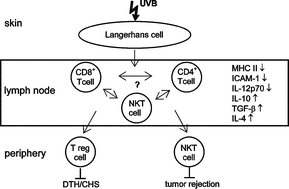Ultraviolet B radiation-induced immunosuppression: molecular mechanisms and cellular alterations†
Abstract
About 30 years ago, the discovery of the connection between UV radiation and the immune system triggered the field of photoimmunology. In that time, many aspects were studied, and a complex picture emerged. UV absorption results in multi-tiered molecular and cellular UV radiation-induced events, eventually affecting the immune system. The shorter wavelengths of the UV spectrum, i.e. UVB appear to be the most critical players for impairing immune reactions. This review summarizes and discusses UVB radiation-induced effects on the skin, considering the primary efferent molecular events following energy absorption of UVB radiation, ending with the various afferent cellular changes, such as induction of regulatory T cells.

- This article is part of the themed collection: 14th International Congress on Photobiology, Korea

 Please wait while we load your content...
Please wait while we load your content...